Frequency response of human vestibular reflexes characterized by stochastic stimuli
- PMID: 17640935
- PMCID: PMC2277188
- DOI: 10.1113/jphysiol.2007.133264
Frequency response of human vestibular reflexes characterized by stochastic stimuli
Abstract
Stochastic vestibular stimulation (SVS) can be used to study the postural responses to unpredictable vestibular perturbations. The present study seeks to determine if stochastic vestibular stimulation elicits lower limb muscular responses and to estimate the frequency characteristics of these vestibulo-motor responses in humans. Fourteen healthy subjects were exposed to unpredictable galvanic currents applied on their mastoid processes while quietly standing (+/-3 mA, 0-50 Hz). The current amplitude and stimulation configuration as well as the subject's head position relative to their feet were manipulated in order to determine that: (1) the muscle responses evoked by stochastic currents are dependent on the amplitude of the current, (2) the muscle responses evoked by stochastic currents are specific to the percutaneous stimulation of vestibular afferents and (3) the lower limb muscle responses exhibit polarity changes with different head positions as previously described for square-wave galvanic vestibular stimulation (GVS) pulses. Our results revealed significant coherence (between 0 and 20 Hz) and cumulant density functions (peak responses at 65 and 103 ms) between SVS and the lower limbs' postural muscle activity. The polarity of the cumulant density functions corresponded to that of the reflexes elicited by square-wave GVS pulses. The SVS-muscle activity coherence and time cumulant functions were modulated by current amplitude, electrode position and head orientation with respect to the subject's feet. These findings strongly support the vestibular origin of the lower limb muscles evoked by SVS. In addition, specific frequency bandwidths in the stochastic vestibular signal contributed to the early (12-20 Hz) and late components (2-10 Hz) of the SVS-evoked muscular responses. These frequency-dependent SVS-evoked muscle responses support the view that the biphasic muscle response is conveyed by two distinct physiological processes.
Figures

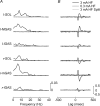
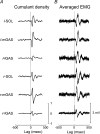
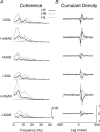
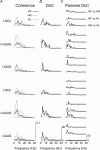
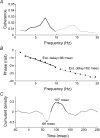
Similar articles
-
Short-duration galvanic vestibular stimulation evokes prolonged balance responses.J Appl Physiol (1985). 2008 Oct;105(4):1210-7. doi: 10.1152/japplphysiol.01398.2006. Epub 2008 Jul 31. J Appl Physiol (1985). 2008. PMID: 18669937
-
Frequency-specific modulation of vestibular-evoked sway responses in humans.J Neurophysiol. 2010 Feb;103(2):1048-56. doi: 10.1152/jn.00881.2009. Epub 2009 Dec 23. J Neurophysiol. 2010. PMID: 20032237
-
The effects of stochastic monopolar galvanic vestibular stimulation on human postural sway.J Vestib Res. 2002-2003;12(2-3):77-85. J Vestib Res. 2002. PMID: 12867666
-
Vestibulospinal influences on lower limb motoneurons.Can J Physiol Pharmacol. 2004 Aug-Sep;82(8-9):675-81. doi: 10.1139/y04-080. Can J Physiol Pharmacol. 2004. PMID: 15523524 Review.
-
Patterning of sympathetic nerve activity in response to vestibular stimulation.Brain Res Bull. 2000 Sep 1;53(1):11-6. doi: 10.1016/s0361-9230(00)00303-8. Brain Res Bull. 2000. PMID: 11033203 Review.
Cited by
-
Changes in vestibular-related responses to combined noisy galvanic vestibular stimulation and cerebellar transcranial direct current stimulation.Exp Brain Res. 2024 Jan;242(1):99-108. doi: 10.1007/s00221-023-06731-5. Epub 2023 Nov 15. Exp Brain Res. 2024. PMID: 37966504
-
Modulation of vestibular-evoked responses prior to simple and complex arm movements.Exp Brain Res. 2020 Apr;238(4):869-881. doi: 10.1007/s00221-020-05760-8. Epub 2020 Mar 11. Exp Brain Res. 2020. PMID: 32157327
-
Short and medium latency muscle responses evoked by electrical vestibular stimulation are a composite of all stimulus frequencies.Exp Brain Res. 2011 Mar;209(3):345-54. doi: 10.1007/s00221-011-2549-7. Epub 2011 Jan 28. Exp Brain Res. 2011. PMID: 21274521
-
Postural threat influences vestibular-evoked muscular responses.J Neurophysiol. 2017 Feb 1;117(2):604-611. doi: 10.1152/jn.00712.2016. Epub 2016 Nov 9. J Neurophysiol. 2017. PMID: 27832609 Free PMC article.
-
Learning to stand with unexpected sensorimotor delays.Elife. 2021 Aug 10;10:e65085. doi: 10.7554/eLife.65085. Elife. 2021. PMID: 34374648 Free PMC article.
References
-
- Amjad AM, Halliday DM, Rosenberg JR, Conway BA. An extended difference of coherence test for comparing and combining several independent coherence estimates: Theory and application to the study of motor units and physiological tremor. J Neurosci Meth. 1997;73:69–79. - PubMed
-
- Brillinger DR. Cross-spectral analysis of processes with stationary increments including the stationary. Ann Probability. 1974;2:815–827.
-
- Britton TC, Day BL, Brown P, Rothwell JC, Thompson PD, Marsden CD. Postural electromyographic responses in the arm and leg following galvanic vestibular stimulation in man. Exp Brain Res. 1993;94:143–151. - PubMed
Publication types
MeSH terms
LinkOut - more resources
Full Text Sources
Medical

